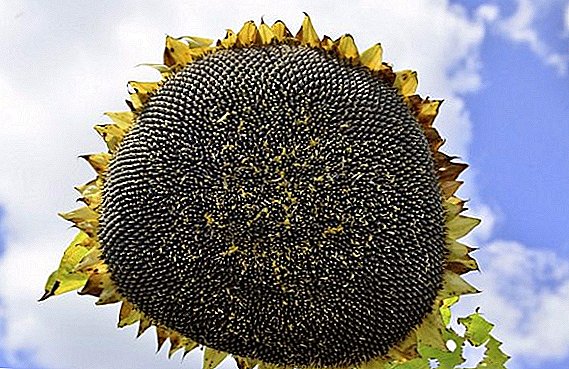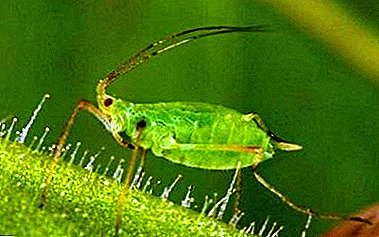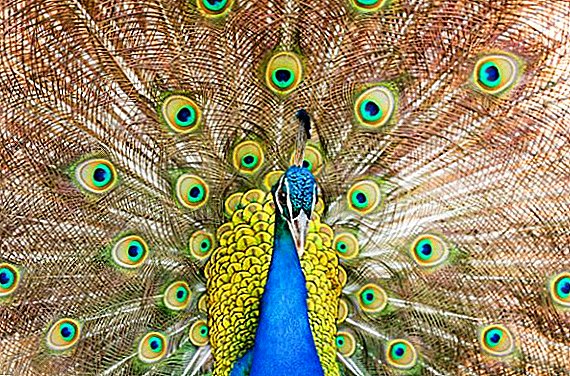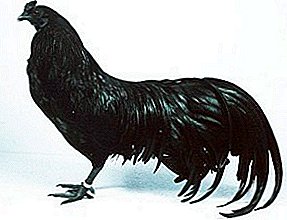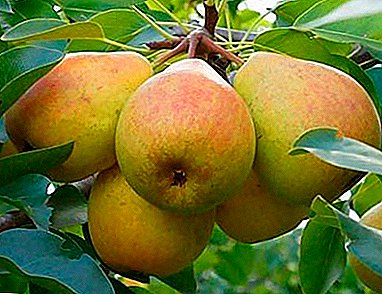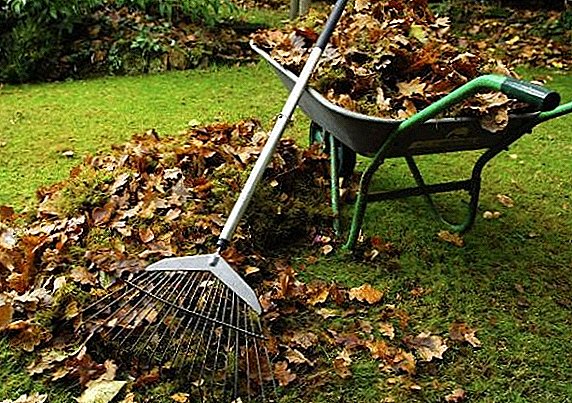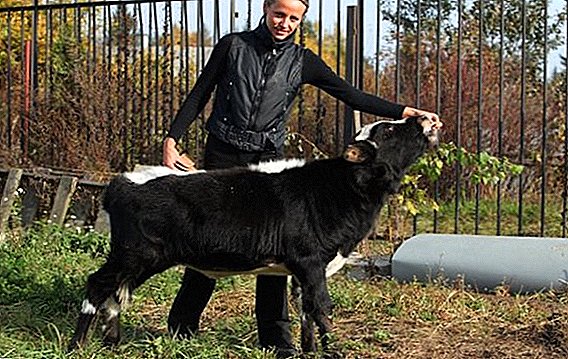 Kanna is a favorite plant with gardeners and gardeners with strange flowers. However, it happens that the canna refuses to bloom, although it seems that all the necessary conditions for it have been created. The answer to the question why cannons are not blooming can vary in each specific situation, but the common cause is always in the wrong care for them.
Kanna is a favorite plant with gardeners and gardeners with strange flowers. However, it happens that the canna refuses to bloom, although it seems that all the necessary conditions for it have been created. The answer to the question why cannons are not blooming can vary in each specific situation, but the common cause is always in the wrong care for them.
 So, good flowering of cann is primarily ensured by creating favorable climatic conditions for these plants. If a plant is planted immediately, without prior awakening and germination, in open ground, it will not make you happy with flowers.
So, good flowering of cann is primarily ensured by creating favorable climatic conditions for these plants. If a plant is planted immediately, without prior awakening and germination, in open ground, it will not make you happy with flowers.
The temperature regime, the humidity of the air, the presence of a sufficient amount of sunlight, the correct irrigation and the fertilized soil also affect flowering.
But if all these conditions are carefully observed, and the plant, nevertheless, does not bloom, it is possible that it is infected with parasites or diseases and needs to be treated.
Cannes pests and ways to control them
Both in domestic and in greenhouse conditions, proper care of the canna ensures the plant is well protected from the harmful effects of parasites. This cannot be said about the situation when cannes are grown in open ground.
Pests of cannes, due to natural migration, have in these conditions direct access to the plant and can cause it much greater harm than the lack of flowering.
Nematodes
 Nematodes small worms are called, plants dwelling in the root system and building “houses” on it in the form of specific growths.
Nematodes small worms are called, plants dwelling in the root system and building “houses” on it in the form of specific growths.
Infection of cannas with nematodes can be caused by too high temperature and humidity, as well as an excess of organic matter in the soil. Under the influence of these parasites, cannes do not receive the required amount of food and water, as a result their development slows down, the plant is deformed and, if not taken timely measures, dies.
Of the effective ways to combat nematodes, the treatment of the soil with hot steam, or with drugs such as carbon disulfide or chloropicrin. For preventive purposes, it is necessary to place the newly acquired plants in quarantine, and individuals strongly affected by the parasite should be immediately removed and destroyed. :
Slugs
 These gastropods eat young cann sprouts and are considered one of the most terrible enemies of this plant. To combat them, the soil should be treated with fungicides, for prevention - digging up, free from weeds and remove the emerging parasites.
These gastropods eat young cann sprouts and are considered one of the most terrible enemies of this plant. To combat them, the soil should be treated with fungicides, for prevention - digging up, free from weeds and remove the emerging parasites.
To help protect the plant from the slugs can mulch the soil around the plant with pine needles, sawdust or peat pillow.
Aphid
 A very common pest that also feeds on young shoots and foliage, sucking the juice out of them, causing the plant to turn white, curl and stop blooming.
A very common pest that also feeds on young shoots and foliage, sucking the juice out of them, causing the plant to turn white, curl and stop blooming.
In addition, the sticky secretions produced by this pest cause other plant diseases, both viral and fungal.
Did you know? Aphids are mainly viviparous insects, and often inside the female an egg is born before the mother is born, that is, newborn insects are born already pregnant.
Aphids in large quantities can be easily seen with the naked eye from the inside of the leaves, in buds and pedicels.
Important! Growing cannes as a houseplant does not guarantee protection from aphids: the insect female can enter the room through an open window or a balcony door and hit the flowers in the pots. Also aphids can be accidentally brought into the house on a bouquet of flowers or a newly acquired houseplant. To prevent this from happening, you should carefully inspect all the flowers before putting them into the room, but it is better to put them in quarantine for a while.
If the aphids on the leaves a little, you can just crush and clean the flower. In case of a more serious injury, the plant is treated with soapy water (however, it must be ensured that the soap does not fall on the soil) or, in particularly severe cases, with special toxic chemicals.
Shchitovka
 This insect is similar in its harmful properties to aphids. It also hides on the back of the leaf, usually where the leaf grows together with the stem, and also sucks the juice from the plant, highlighting the sticky substance that causes fungal diseases.
This insect is similar in its harmful properties to aphids. It also hides on the back of the leaf, usually where the leaf grows together with the stem, and also sucks the juice from the plant, highlighting the sticky substance that causes fungal diseases.
Shchitovka can kill cannes, so it is necessary to fight it in the early stages. Insects need to be removed from the leaves, and the plant itself sprayed "Vertimekom".
In order to avoid infection of neighboring plants, infected flowers must be quarantined.
Spider mite
 A very dangerous pest for cannes is spider mite - a small red-brown or white spider settling on the back of the leaf and covering the plant with white cobwebs.
A very dangerous pest for cannes is spider mite - a small red-brown or white spider settling on the back of the leaf and covering the plant with white cobwebs.
The pest sucks the juice from the plant and, in addition, is a carrier of fungal and viral infections. Under the influence of this tick, the leaves eventually dry up and the plant dies.
The spider mite feels very comfortable in dry air, therefore regular spraying of cann is a good prevention of infection.
If the plant is sick, it should be treated with special (Vertimek, Mavrik, etc.) or self-made (for example, a decoction of cyclamen tubers, a soap solution of Persian chamomile) preparations. The procedure is carried out twice with a break of 5-6 days.
Viral diseases canna and how to deal with them
 Canna is a plant that is fairly resistant to various diseases. The most frequent diseases affecting cannes include cucumber mosaic and variegation.
Canna is a plant that is fairly resistant to various diseases. The most frequent diseases affecting cannes include cucumber mosaic and variegation.
Cucumber Mosaic Virus
It is usually transmitted by aphids (it is very attracted to substances that the infected plant begins to produce) and other insect-peddlers, but it can also get to the plant from weeds (for example, field sowing) or from other flowers infected with the virus.
The virus can be recognized by the characteristic thread-like formations that appear on the leaves of cann.
Did you know? The virus of a cucumber mosaic is not inferior in its speed and ease of spreading to the influenza virus. As in the case of the flu, the only way to combat the pathogen is the appearance of immunity in the surviving plant disease. Plants of any age are equally affected by this virus.
 Treat cucumber mosaic, like other viral diseases, is almost impossible, it is better to provide good prevention. At the slightest sign of infection, the plant must be removed, preventing its contact with "neighbors".
Treat cucumber mosaic, like other viral diseases, is almost impossible, it is better to provide good prevention. At the slightest sign of infection, the plant must be removed, preventing its contact with "neighbors".
Inventory and other tools with which the area is treated should be periodically disinfected. Weeding and weeding control of aphids, the main peddler of the virus, are also prophylactic measures.
Variegation
 Variegation manifested by specific black dots on canna leaves. This virus is less dangerous than the cucumber mosaic, but in advanced cases it can lead to deformation of the flowers and reduce their size.
Variegation manifested by specific black dots on canna leaves. This virus is less dangerous than the cucumber mosaic, but in advanced cases it can lead to deformation of the flowers and reduce their size.
You can fight the disease only by removing the infected leaves.
Fungal diseases canna and how to deal with them
Fungal diseases, like viral ones, are not actually treated. In order for the plant not to get sick, you should dig up the soil well before the onset of winter, carefully removing and destroying the remnants of plants on which fungal spores can persist.
Rust Mushroom

Rust fungus occurs against the background of excess moisture.
In the first stages brown spots appear on the leaves of cann, later they dry up and fall off.
Fungus infestation occurs with lightning speed, therefore the treatment of this disease is generally impossible..
Gray rot
The causative agent of this disease is a special mushroom called botrytis.
Important! For the active growth of botrytis, a combination of two factors is necessary: high humidity and low air temperature.
Externally, the disease manifests itself as a gray, mold-like bloom that covers the stems, buds and canna flowers. Infected parts of the plant become soft and brown.
The leaves on the edges are covered with brown spots, quickly spreading over the entire surface and causing the leaf to die. Spores of the fungus are very quickly able to spread to other plants.
 Preventive measures consist in the proper planting of plants (with sufficient distance from each other), watering at the root, weed control, as well as timely and dosed fertilization (excess nitrogen makes cannes more susceptible to the fungus).
Preventive measures consist in the proper planting of plants (with sufficient distance from each other), watering at the root, weed control, as well as timely and dosed fertilization (excess nitrogen makes cannes more susceptible to the fungus).
Cannes can not be called whimsical plants, to care for them is quite simple. And yet, like any living organism, these flowers have their natural enemies.
Unfortunately, it is much more difficult to fight with many diseases of cannes than to prevent them. Show a little attention, and these beautiful exotic plants will constantly delight you with their bright luxurious flowers!


